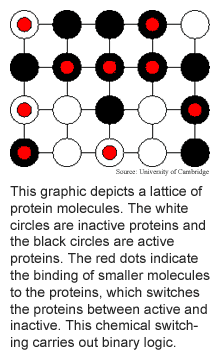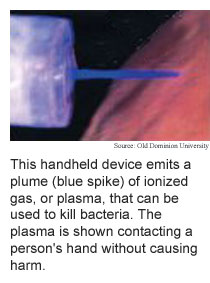
Week
of September 26, 2005
Protein
logic digitizes cells
Brain researchers often use the analogy of brain as computer to
frame their work. As it turns out, the analogy is also handy for examining
the complex biochemical interactions inside individual cells.
 Researchers from the University of Cambridge in England have developed
a mathematical model
of the biochemical interactions of protein molecules within cells that
shows that proteins are capable of carrying out the basic binary logic
functions of computing. They also showed that this type of binary logic
appears to be at work in E. coli. bacteria.
Researchers from the University of Cambridge in England have developed
a mathematical model
of the biochemical interactions of protein molecules within cells that
shows that proteins are capable of carrying out the basic binary logic
functions of computing. They also showed that this type of binary logic
appears to be at work in E. coli. bacteria.
The logic is carried out by the actions of small molecules that
bind to the larger protein molecules and change the shapes of the proteins,
which switches them between active and inactive states. The protein binding
process can implement AND, OR and XOR logic
gates.
The work isn't likely to lead to computers made from bacteria
anytime soon, but it does present a new perspective for understanding
the complex biochemical network of life, which in turn could lead to better
understanding and treatment of diseases.
(The Logical Repertoire of Ligand-Binding Proteins, Physical Biology,
September 2005)
Spray-on solar cell manufacturing
Researchers from Delft University of Technology in the Netherlands
have developed a low-cost spray-on
manufacturing technique for making solar cells.
The solar cells have an energy conversion efficiency of five percent.
This is considerably lower than traditional silicon wafer solar cells,
which have efficiencies of up to 30 percent, but the much simpler manufacturing
process has the potential to lower the cost per kilowatt, according to
the researchers.
The key component, which is applied by spraying, is a mix of copper
indium sulfide and titanium dioxide nanoparticles sandwiched between a
thin film of titanium dioxide and a layer of titanium dioxide nanocrystals.
The copper indium sulfide nanoparticles absorb sunlight and the titanium
dioxide nanoparticles convert photons to electrons.
Other researchers have combined organic dyes with titanium dioxide
to make solar cells, but these organic materials degrade more readily
when exposed to moisture and oxygen than copper indium sulfide.
The technique could make solar cells an economically competitive
form of electricity generation, according to the researchers
(Nanocomposite Three-dimensional Solar Cells Obtained by Chemical
Spray Deposition, Nano Letters, September 14, 2005)
Biochip spots cancer signs
The practice of chemically "functionalizing" carbon nanotubes
and semiconductor nanowires by attaching DNA or other biomolecules to
them has led to prototype biochips that can detect bacteria, viruses,
specific types of DNA, or particular proteins molecules.
Researchers from Harvard University had advanced the field with
a nanowire
sensor array that can detect multiple biochemical signs of cancer.
Cancer cells produce different types of proteins, and today's blood tests
often look for only one, such as the prostate specific antigen (GSA).
The biochip works by measuring changes in electrical conductance
of nanowires as specific protein molecules bind to and release from the
chip's nanowires. The researchers tested the biochip using blood samples.
The device could eventually be used for clinical diagnostics, including
detecting and identifying cancers.
The researchers used a similar technique last year to make a biochip
that can detect individual virus particles.
(Multiplexed Electrical Detection of Cancer Markers with Nanowire
Sensor Arrays, Nature Biotechnology, published online September 18, 2005)
Plasma pen to fight plaque
In the not too distant future, your dental hygienist might stick
what looks like a small blowtorch into your mouth. It shouldn't hurt,
though, because the device will be emitting cold plasma rather than hot
flame.
 Plasmas are ionized gases, meaning the gas atoms carry an electric
charge because they have lost or gained electrons. Plasmas typically exist
in high-temperature environments like stars, and in low-pressure environments
like the vacuum of outer space. Researchers have recently been able to
reliably produce cold plasmas, which are room-temperature plasmas at atmospheric
pressure.
Plasmas are ionized gases, meaning the gas atoms carry an electric
charge because they have lost or gained electrons. Plasmas typically exist
in high-temperature environments like stars, and in low-pressure environments
like the vacuum of outer space. Researchers have recently been able to
reliably produce cold plasmas, which are room-temperature plasmas at atmospheric
pressure.
Researchers from Old Dominion University have developed a low-power,
hand-held
cold plasma generator that produces a plasma plume several centimeters
long.
Plasmas are useful for sterilization because they destroy bacteria
by breaking down their cell membranes. The researchers' device could eventually
be used for medical and dental care.
(Room-temperature Atmospheric Pressure Plasma Plume for Biomedical
Applications, Applied Physics Letters, September 12, 2005)
Bits and pieces
A robust organic
thin-film promises high-speed memory; an organic
salt turns direct current into alternating current, a job ordinarily
handled by electronic circuits in electric motors and refrigerators; an
experiment
measured how much an atom's wavelength shifts as it approaches a surface,
providing a useful benchmark for researchers developing devices at the
nanoscale.
RSS Feeds: News Blog Books New: TRN's Internet Services TRN's Jobs Center News: Research News Roundup Research Watch blog Features: View from the High Ground Q&A How It Works Buy an ad link |
|
| Advertisements: |
|
Ad links: Clear History
Buy an ad link
|
TRN
Newswire and Headline Feeds for Web sites
|